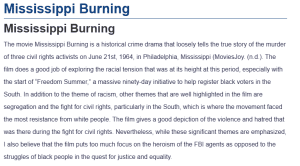Mississippi Burning
The movie Mississippi Burning is a historical crime drama that loosely tells the true story of the murder of three civil rights activists on June 21st, 1964, in Philadelphia, Mississippi (MoviesJoy. (n.d.). The film does a good job of exploring the racial tension that was at its height at this period, especially with the start of “Freedom Summer,” a massive ninety-day initiative to help register black voters in the South. In addition to the theme of racism, other themes that are well highlighted in the film are segregation and the fight for civil rights, particularly in the South, which is where the movement faced the most resistance from white people. The film gives a good depiction of the violence and hatred that was there during the fight for civil rights. Nevertheless, while these significant themes are emphasized, I also believe that the film puts too much focus on the heroism of the FBI agents as opposed to the struggles of black people in the quest for justice and equality.
In the 1960s, the cultural context of Mississippi was made up of two dominant groups, including African Americans and White Southerners. The former comprised about forty percent of the population and were subjected to harsh legal and social discrimination that led to being marginalized, oppressed economically, and segregated in education. This led to the culture of resistance, which gave rise to the civil rights movement. Notably, this movement was in agreement with the Northern ideology and federal law, which aimed to reconcile Southern practices with the ideologies of equality enshrined in federal law. The latter, however, had both political, social, and economic dominance with ideologies that were deeply ingrained in white supremacy. They believed in the “Southern way of life,” which comprised desegregation and opposing federal intervention. In addition, the civil rights movement and the adoption of the Northern ideology were perceived as a direct threat to their social order. As such, they resisted the implementation of the Civil Rights Act, which was passed in 1974. This led to violent resistance from state officials and white supremacy groups like the KKK. In regards to using it in their work, I would argue that Chaney, as a black man, did not have any. As for the other two, Goodman and Schwerner, being white Northern Jews, may have had a privilege that allowed them to challenge Southern racism. Unfortunately, being Jews also put them in a foreigner or outsider category, which reduced the protection being white offered them.
After analyzing how the Civil War continued to impact social discourse through generational racism, even after it ended in the late nineteenth century, culturally grounded social work approaches from both generational and diversity approaches would mainly be about advocating for distributive justice. Places like Mississippi that have a history of racism tend to have systems in place that have disadvantaged minority groups while favoring the majority. Examples of systemic oppression include residential segregation, lack of funding in schools within minority communities, denial of loans and mortgages to minority groups, and less allocation of resources and opportunities to said groups (Marsiglia et al., 2021). As such, culturally grounded social work would promote fair resource allocation based on needs assessments. Rather than giving all communities equal resources, social work would play a part in assessing which communities have been disadvantaged for centuries and need more resources than others. The current Mississippi, like most of America, especially in the South, still struggles with the legacy of racial inequality. Even with considerable changes like the election of black leaders, systemic racism is still a major problem that continues to affect the community and is evident through economic disparities, educational inequities, the criminal justice system, and healthcare disparities (Simpson, 2021).
References
Marsiglia, F. F., Kulis, S. S., & Lechuga-Peña, S. (2021). Diversity, oppression, and change: Culturally grounded social work. Oxford University Press, USA.
MoviesJoy. (n.d.). Mississippi burning. Moviestojoy. https://moviesjoy.is/movie/mississippi-burning-18091
Simpson, A. (2021). In the rural south, poor health tied to systemic racism and legacy of slavery. The Center for Public Integrity. https://publicintegrity.org/inside-publici/newsletters/watchdog-newsletter/south-poor-health-tied-racism-slavery-medicaid-expansion/
ORDER A PLAGIARISM-FREE PAPER HERE
We’ll write everything from scratch
Question

Mississippi Burning
Please take a moment to share your thoughts about the movie Mississippi Burning. Explore the context of multiculturalism in Mississippi (in 1964) and its association to assimilation with Northern ideology and Federal Law. How many cultures existed? Explore how civil rights workers’ Chaney, Goodman, and Schwerner, used their privilege for social change, social justice, and advocacy. Examine how the Civil War, which ended in 1865, continued to impact social discourse through generational racism. What would a culturally grounded social work approach look like from generational and diversity approaches? What is it like today?

